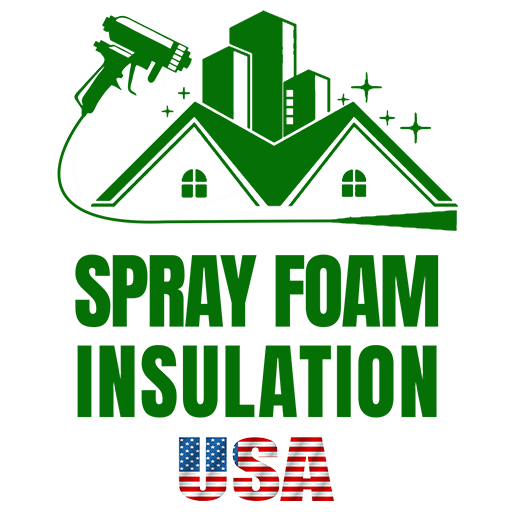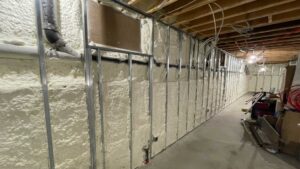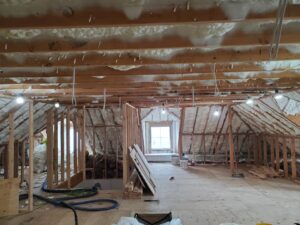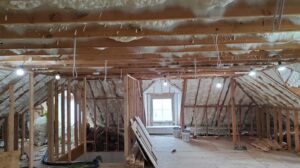If you’re searching for spray foam wall insulation, here’s what you need to know in a nutshell:
- Energy Efficiency: Spray foam insulation has high R-values, reducing your energy bills.
- Comfort Year-round: Offers excellent air sealing, maintaining your home’s temperature.
- Eco-Friendly: Lowers the carbon footprint of your home.
- Longevity: Doesn’t settle or degrade over time like other insulations.
For homeowners and business owners in NY and NJ seeking to enhance the energy efficiency and comfort of their spaces, while also committing to a greener planet, spray foam insulation for walls represents a significant step forward.
Spray foam insulation is not just about insulating your home; it’s about transforming it into an energy-efficient, comfortable haven that stands the test of time. Offering unmatched air sealing capabilities, it can dramatically reduce your energy bills and decrease your carbon footprint—a perfect match for those who value quality, expertise, and sustainable practices.
This introduction kicks off our guide on how spray foam insulation can revolutionize your walls. By choosing the correct type of spray foam and properly preparing for its application, you’ll enjoy benefits that far surpass traditional insulating methods. Throughout this guide, we’ll walk you through everything from understanding different types of spray foam to the application process and address frequently asked questions.
Understanding Spray Foam Insulation
When we talk about insulating your home, particularly the walls, spray foam insulation stands out for its efficiency and versatility. But, not all spray foam is created equal. There are two main types you’ll encounter: open-cell and closed-cell. Let’s dive into what each of these means and how they can benefit your home.
Open-Cell Spray Foam Insulation
Imagine a sponge – soft, flexible, and full of air. That’s essentially what open-cell spray foam insulation is like. It has tiny cells that aren’t completely closed, allowing air to fill these spaces.
- Pros:
- It’s more affordable than closed-cell foam.
- Great for soundproofing because of its density.
-
It’s easier to apply in nooks and crannies due to its expansion capability.
-
Cons:
- It has a lower R-value per inch, meaning it’s not as efficient in blocking heat flow.
- It absorbs moisture, which might not be ideal in damp environments.
Closed-Cell Spray Foam Insulation
Now, picture a hard, dense foam where each cell is completely closed off from the others. This is closed-cell foam, which is much denser and more moisture-resistant than its open-cell counterpart.
- Pros:
- Higher R-value per inch, providing superior insulation and reducing energy costs.
- Acts as a vapor barrier, preventing moisture from passing through.
-
Adds structural strength to the walls it’s applied to.
-
Cons:
- It’s more expensive due to its density and the materials used.
- It’s harder and doesn’t expand as much, which might limit its use in tight spaces.
Choosing the Right Type for Your Home
The choice between open-cell and closed-cell spray foam insulation depends on your specific needs. If you’re looking for soundproofing and cost-effectiveness, open-cell might be the way to go. However, if you need higher insulation values, moisture resistance, and are willing to invest a bit more, closed-cell is the superior choice.
Both types have their place in making homes more energy-efficient and comfortable. It’s not just about keeping warm or cool air in; it’s also about creating a healthier living environment by reducing the chances of mold and improving air quality.
The right insulation can significantly impact your energy bills and the overall comfort of your home. Whether you choose open-cell or closed-cell, spray foam wall insulation is a powerful tool in your home’s energy efficiency arsenal.
We’ll delve into how to prepare your walls for spray foam insulation, ensuring they’re ready to receive this energy-saving upgrade.
Preparing Your Walls for Spray Foam Insulation
Before diving into spray foam wall insulation, there’s some groundwork to be done. Think of it as setting the stage for a performance where every detail matters. Let’s break down the steps:
Cleaning
First things first, your walls need to be clean. This doesn’t mean a simple dust-off; it means ensuring that the surface is free of any materials that might hinder the adhesion of the foam. Paint, oil, or any sort of residue can affect how well the spray foam sticks to your walls. A clean surface ensures that the foam can form a solid, unbreakable bond, leading to better insulation.
Dust Removal
Dust might seem harmless, but it’s essentially tiny particles that can get in the way of the foam creating a seamless barrier on your walls. Use a vacuum with a brush attachment to gently but thoroughly remove any dust from the wall surface. This step is crucial because dust can prevent the spray foam from adhering properly, leading to gaps in insulation.
Moisture Check
Moisture and insulation are not friends. Before applying spray foam insulation, it’s vital to check your walls for any signs of moisture. Moisture can come from leaks, condensation, or even the ground, and it can cause significant problems if trapped inside your walls by the insulation. Use a moisture meter to check the levels in your walls. The acceptable moisture content in walls should be below 19% before applying spray foam. If you find high moisture levels, address the source of the moisture before proceeding with insulation.
The goal here is to create the best possible conditions for the spray foam to adhere to your walls and perform its insulating duties effectively. Skipping these preparatory steps can lead to subpar insulation performance, moisture problems, and even structural issues down the line. So, take your time, do it right, and your walls will be perfectly prepped for spray foam insulation.
As we move on to the next section, keep in mind that the effort you put into preparing your walls will directly impact the effectiveness of your spray foam wall insulation. Proper preparation is the key to unlocking all the benefits spray foam has to offer.
The Application Process of Spray Foam Insulation
Once your walls are clean, dry, and free from dust and debris, you’re ready to dive into the application process of spray foam wall insulation. This step is crucial for ensuring your home becomes more energy-efficient and comfortable. Let’s break down the process into manageable parts: Preparation, Application, Expansion and Curing.
Preparation
Before the actual application begins, double-check that your workspace is well-ventilated and that you have all necessary safety gear, including gloves, goggles, and a mask. It’s also essential to ensure that the spray foam insulation kits are at the correct temperature recommended by the manufacturer for optimal results. This detail can significantly affect the foam’s expansion and curing properties.
Application
The application starts with mixing the two components that make up the spray foam. This usually happens within the spray gun as the chemicals are fed from separate tanks. Once mixed, the liquid foam is sprayed directly onto the wall surface.
- Keep the Gun Moving: To ensure even coverage, keep the spray gun moving in a smooth, consistent motion.
- Apply in Thin Layers: It’s tempting to go thick, but thinner layers allow for better expansion and reduce the risk of uneven insulation.
- Maintain the Right Distance: Holding the spray gun too close or too far can affect the foam’s application. A distance of 18 to 24 inches is typically recommended.
Expansion and Curing
After application, the magic begins. The liquid foam expands rapidly to fill gaps, cracks, and crevices, creating an airtight seal. This expansion can be up to 30-60 times its liquid volume, depending on whether you’re using open-cell or closed-cell foam. The foam starts to cure and harden within minutes, but it can take up to 24 hours to fully cure.
- Watch the Foam Expand: The foam will grow significantly, so it’s crucial to apply the correct amount to avoid over-expansion.
- Allow Adequate Curing Time: Even though the foam feels dry to touch within minutes, it’s important to give it enough time to cure fully before covering it with drywall or other materials.
Remember: The quality of the application can make or break the effectiveness of your insulation. Following the manufacturer’s guidelines and ensuring proper application techniques will help maximize the benefits of spray foam wall insulation.
It’s essential to weigh the advantages and potential drawbacks of choosing spray foam wall insulation for your home. The next section will delve into the pros and cons, helping you make an informed decision.
Pros and Cons of Spray Foam Wall Insulation
When considering spray foam wall insulation for your home, it’s important to understand both the benefits and the possible downsides. This type of insulation offers unique advantages over traditional insulation materials, but it also comes with its own set of considerations. Let’s break it down:
Pros
-
Excellent Coverage: Spray foam insulation expands to fill cracks, gaps, and hard-to-reach places. This ensures a tight seal and comprehensive coverage, leaving no space uninsulated. This is particularly beneficial in walls where preventing air leakage is crucial for maintaining indoor temperature and comfort.
-
Long-lasting: Once applied, spray foam insulation adheres strongly to the surfaces of your walls, creating a durable and long-lasting barrier. Unlike some other insulation materials that may sag or settle over time, spray foam retains its shape and effectiveness, potentially lasting the lifetime of your home.
-
High R-Value: Spray foam insulation boasts a high R-value, which measures its resistance to heat flow. With values ranging from R-3.5 to R-6.5 per inch, spray foam can significantly enhance your home’s energy efficiency, leading to lower heating and cooling costs.
-
Air and Vapor Barrier: Closed-cell spray foam acts as both an air and vapor barrier. This dual function can help prevent moisture-related issues such as mold and mildew, contributing to a healthier indoor environment and protecting the structural integrity of your home.
Cons
-
Cost: One of the main drawbacks of spray foam insulation is its cost. It is generally more expensive than traditional insulation materials like fiberglass or cellulose. However, the initial investment may be offset by energy savings and the durability of the product over time.
-
Messiness: The application process of spray foam insulation can be messy. The foam is sticky and expands rapidly, so precise application is crucial to avoid overspray and ensure a clean finish. This is why professional installation is recommended.
-
Long Dry Time: After application, spray foam needs time to expand fully and cure. During this period, the chemicals used in the foam can emit odors and vapors that may be unpleasant or harmful if inhaled. It’s advisable to vacate the premises for a few days post-application to allow for proper drying and airing out.
In conclusion, while spray foam wall insulation offers superior coverage, longevity, and energy efficiency, it’s important to consider the higher cost, potential messiness during application, and the curing time required. By understanding these pros and cons, you can make a more informed decision about whether spray foam insulation is the right choice for your home.
Let’s address some frequently asked questions about spray foam wall insulation to help clear up any remaining uncertainties.
FAQs About Spray Foam Wall Insulation
When considering spray foam wall insulation, you likely have questions. Let’s dive into some of the most common inquiries.
Can Spray Foam Insulation Be Applied to Existing Walls?
Yes, spray foam insulation can be applied to existing walls. This process involves injecting the foam into wall cavities, often through small holes drilled from the outside or inside of the wall. This method is particularly effective for upgrading insulation without the need for extensive renovation. A case study mentioned in the research above highlighted a homeowner who successfully insulated their garage by having a professional fill the wall cavities with dense spray foam, significantly improving temperature retention and reducing noise from outside.
Is Spray Foam Insulation Safe for Indoor Use?
Absolutely, when properly installed and cured, spray foam insulation is safe for indoor use. It’s crucial to allow the foam to cure fully before occupying the space, as the chemicals used in the application process can emit fumes that are harmful if inhaled in their uncured state. The US EPA notes that once cured, spray foam insulation does not off-gas harmful chemicals, making it safe for indoor environments. However, it’s recommended to use a professional installer who can ensure the product is applied safely and correctly.
How Does Spray Foam Insulation Compare to Traditional Insulation in Terms of R-Value?
Spray foam insulation often outperforms traditional insulation materials in terms of R-value, which measures an insulation material’s resistance to heat flow. Closed-cell spray foam has an R-value of about 6.5 – 7 per inch, making it one of the most efficient insulating materials available. In comparison, traditional fiberglass insulation typically offers an R-value of about R-2.2 to R-4.0 per inch. This higher R-value means spray foam insulation can provide superior thermal resistance with less material, making it an effective choice for both new construction and retrofitting existing structures.
In summary, spray foam wall insulation can be a highly effective solution for enhancing your home’s energy efficiency and comfort. Whether you’re upgrading existing walls or building anew, understanding these key points can help you make an informed decision.
Conclusion
As we wrap up our guide on spray foam wall insulation, emphasize the role of sustainability and how choosing Spray Foam Insulation USA aligns with eco-friendly practices and energy conservation.
Sustainability is more than just a buzzword; it’s a commitment to reducing our environmental footprint and making choices that benefit both our immediate surroundings and the planet at large. Spray foam insulation stands out in this regard due to its exceptional ability to seal homes from air and moisture infiltration, save on costly utility bills, reduce the use of fossil fuels in heating and cooling, and contribute to a reduction in greenhouse gas emissions.
Spray Foam Insulation USA is not just a provider of high-quality insulation services; we’re a partner in your journey towards creating a more sustainable, comfortable, and energy-efficient home. Our products are designed with the environment in mind, offering solutions that not only meet but exceed expectations in terms of performance and environmental stewardship.
Choosing spray foam wall insulation means making a long-term investment in your home’s efficiency and comfort, while also contributing to a larger cause of energy conservation and environmental protection. It’s a step towards a future where we live in harmony with our environment, optimizing our resources while minimizing our impact.
At Spray Foam Insulation USA, we’re committed to providing you with not just insulation, but a path to a greener, more sustainable way of living. Our team of experts is ready to guide you through the process, ensuring that your home benefits from the highest quality spray foam insulation available.
Ready to make a difference? Let’s work together to create a more energy-efficient, comfortable, and sustainable home. Contact us today to learn more about how spray foam insulation can transform your living space and contribute to a healthier planet. Together, we can make a significant impact, one insulated wall at a time.





